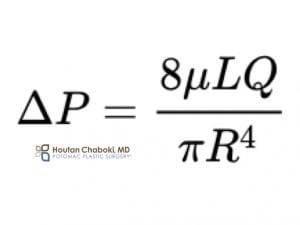Breathe better and snore less without surgery. Dr. Chaboki offers nonsurgical options for nasal obstruction.
Nasal obstruction, limited airflow through the nose, is a common complaint of patients who are seeking rhinoplasty. However, chronic nasal obstruction affects many more patients that those seeking rhinoplasty and affects millions of individuals. Patients with nasal obstruction typically visit the primary care physician first before seeking specialist care.
Nasal obstruction can present with symptoms such as congestion, blocked sinuses, narrow nasal passages, or stuffy nose. Other symptoms or signs of nasal obstruction may include decreased smell, snoring, post nasal drip, dry mouth, headaches, mouth breathing, or chronic dental issues (ex. TMJ).
Breath better.
What is Nasal Obstruction?
Chronic nasal obstruction is the reduced ability to breathe through the nasal passages. Many conditions of the nose and sinus passageways contribute to blockage. The primary categories of nasal blockage are structural (ex. bone, cartilage, scar tissue) or inflammatory (ex. swelling, mucous).
Structural changes can arise from normal facial and nose development or result from prior trauma (broken nose) or surgery (rhinoplasty). Inflammatory changes to the mucous membranes of the nose leads to swelling and increased mucous production inside the nose.

Airflow through the nose is partially explained by physics.
Any degree of blockage, structural and/or inflammatory, greatly reduces airflow (see equation above). Nasal airflow is analogous to flow of fluid through a straw. It’s much harder to drink water through a small straw, as compared to a larger straw. Even a small difference in the straw’s opening diameter makes a big difference in flow rate of fluid.
Why treat Nasal Obstruction?
In addition to symptoms of nasal blockage, patients with obstruction can report problems sleeping, snoring, sleep apnea, fatigue, or unrestful sleep despite the number of hours sleeping. Spouses and partners are secondarily bothered by this effect of nasal obstruction.
Nasal obstruction may affect various professions too. Athletes can report nasal obstruction impacting performance and ability to perform at their peak potential. Allergy sufferers may have tried countless spray and antihistamines and still have nasal obstruction and drainage. Singers, actors, and performers may complain of a nasal voice or hyponasal speech due to nasal blockage. Teachers, lawyers, and politicians may feel they have a weak voice and don’t project as well as they desire due to nasal blockage.
Surgical treatment of Nasal Obstruction
A broad spectrum of surgery can treat chronic nasal obstruction, such as
- rhinoplasty, ex. broken nose repair
- septoplasty, ex. deviated septum bone spur
- turbinate reduction, ex. swollen turbinates
- nasal valve repair, ex. narrow nostril passages
- endoscopic sinus surgery, ex. balloon blocked sinuses
Read more about surgical management of nasal obstruction by Dr. Chaboki in the multiple links above. Many patients are potential candidates for surgery. An evaluation is required to determine appropriate options.
Nonsurgical treatment of Nasal Obstruction
Other than surgery, saline rinses, allergy medications, decongestants, or external breathing strips may be the first options offered to patients by their primary care physicians. Unfortunately, these nonsurgical treatments may not work in everyone or can result in just temporary relief.
Dr. Chaboki, a specialist facial plastic surgeon, offers various nonsurgical and surgical options for chronic nasal obstruction, ranging from minor in-office procedures all the way to complex nasal reconstruction. In fact, many specialist ENT (ear, nose, throat) physicians often refer to Dr. Chaboki for his expertise on the nose and sinuses.
New options available for Nasal Obstruction
The newest method offered by Dr. Chaboki to treat nasal obstruction uses radio frequency (RF). RF is a relatively new office treatment that creates controlled heat under the surface of the target area inside the nose. Tissue is not removed during RF. Tissue volume at the target site shrinks after treatment, with some volume reduction may be noticeable immediately. RF has been used on the inferior turbinate for years and now available to treat other areas inside the nose, such as the nasal valve.
When can I get RF treatment for Nasal Obstruction?
RF is a non-invasive approach to reshape nasal tissue. There is no tissue cutting. Researches that have studied RF found that, in select applications, the nasal cartilage can subtly denature and change its shape enough to open the nasal valve and improve airflow. Remember that even a small difference in space inside the nose can dramatically improve nasal airflow.
Dr. Chaboki uses RF technology in patients with nasal obstruction who are not surgical candidates. RF may still be appropriate for those referred to Dr. Chaboki who had prior nasal and sinus surgery, or rhinoplasty, and still have symptomatic nasal obstruction.
The office RF procedure takes a few minutes and performed via awake, local anesthesia. Packing and sutures are not used. There aren’t external casts or splints either. Patient can return to work the same day as desired. Most patients require just one treatment for long-lasting results.
Snore less.
Contact the office to schedule an evaluation. Dr. Chaboki can determine if you are a candidate for an office procedure to treat nasal obstruction. The office is one of the only rhinoplasty specialists who offers this specific nonsurgical treatment in Washington DC region.


Leave a Reply